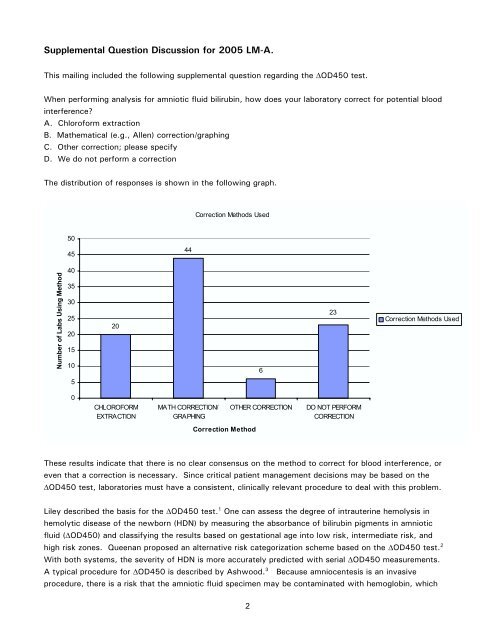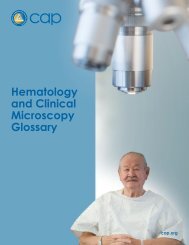Amniotic Fluid Bilirubin (LM1) - Supplemental Question Discussion
Amniotic Fluid Bilirubin (LM1) - Supplemental Question Discussion
Amniotic Fluid Bilirubin (LM1) - Supplemental Question Discussion
You also want an ePaper? Increase the reach of your titles
YUMPU automatically turns print PDFs into web optimized ePapers that Google loves.
<strong>Supplemental</strong> <strong>Question</strong> <strong>Discussion</strong> for 2005 LM-A.<br />
This m ailing included the follow ing supplem ental question regarding the O D450 test.<br />
W hen perform ing analysis for am niotic fluid bilirubin, how does your laboratory correct for potential blood<br />
interference?<br />
A. Chloroform extraction<br />
B. M athem atical (e.g., Allen) correction/graphing<br />
C. O ther correction; please specify<br />
D. W e do not perform a correction<br />
The distribution of responses is show n in the follow ing graph.<br />
Num ber of Labs Using Method<br />
50<br />
45<br />
40<br />
35<br />
30<br />
25<br />
20<br />
15<br />
10<br />
5<br />
0<br />
20<br />
CHLOROFORM<br />
EXTRACTION<br />
44<br />
MATH CORRECTION/<br />
GRAPHING<br />
Correction Methods Used<br />
Correction Method<br />
2<br />
6<br />
23<br />
OTHER CORRECTION DO NOT PERFORM<br />
CORRECTION<br />
Correction Methods Used<br />
These results indicate that there is no clear consensus on the m ethod to correct for blood interference, or<br />
even that a correction is necessary. Since critical patient m anagem ent decisions m ay be based on the<br />
O D450 test, laboratories m ust have a consistent, clinically relevant procedure to deal w ith this problem .<br />
Liley described the basis for the O D450 test. 1 O ne can assess the degree of intrauterine hem olysis in<br />
hem olytic disease of the new born (HDN) by m easuring the absorbance of bilirubin pigm ents in am niotic<br />
fluid (O D450) and classifying the results based on gestational age into low risk, interm ediate risk, and<br />
high risk zones. Q ueenan proposed an alternative risk categorization schem e based on the O D450 test. 2<br />
W ith both system s, the severity of HDN is m ore accurately predicted w ith serial O D450 m easurem ents.<br />
A typical procedure for O D450 is described by Ashw ood. 3 Because am niocentesis is an invasive<br />
procedure, there is a risk that the am niotic fluid specim en m ay be contam inated w ith hem oglobin, w hich
has an absorbance peak at 410 nm. The amniotic fluid specimen should be centrifuged before<br />
spectrophotometric scanning to remove red blood cells or other particulate matter. If there is an<br />
oxyhemoglobin peak at 410 nm, one can correct the OD450 by subtracting 5% of the OD410.<br />
An alternative correction for the presence of hemoglobin in the amniocentesis specimen is extraction of the<br />
bilirubin fraction into chloroform before performing the scanning spectrophotometry. 4,5 However,<br />
chloroform extraction reduces the OD450, even when no hemoglobin is present. 6 If chloroform extraction<br />
is used, all specimens should be subjected to chloroform extraction, not just the specimens that are visibly<br />
contaminated with blood. Otherwise, OD450 results obtained on two serial amniotic fluid specimens from<br />
the same patient, one of which was extracted and the other of which was not extracted, may lead to an<br />
incorrect interpretation about the trend of the OD450 measurements and the clinical course of the HDN.<br />
Furthermore, since the Liley graph that is used to interpret the OD450 result was created using<br />
unextracted material, some authors have suggested that a new Liley graph should be constructed using<br />
chloroform-extracted material. 6<br />
References:<br />
David S. Wilkinson, MD, PhD<br />
Chemistry Resource Committee<br />
1. Liley AW. Liquor amnii analysis in the management of the pregnancy complicated by rhesus<br />
sensitization. Am J Obstet Gynecol. 1961;82:1359-70.<br />
2. Queenan JT, Tomai TP, U ral SH, K ing JC. Deviation in amniotic fluid optical density at a wavelength of<br />
450 nm in Rh-immunized pregnancies from 14 to 40 weeks’ gestation: a proposal for clinical<br />
management. Am J Obstet Gynecol. 1993;168:1370-6.<br />
3. Ashwood ER. Determnation of A450 in amniotic fluid. In: Burtis CA, Ashwood ER, eds. Tietz<br />
textbook of clinical chemistry, 3 rd ed. Philadelphia: WB Saunders, 1999:1768-70.<br />
4. Hochberg CJ, Witheiler AP, Cook H. Accurate amniotic fluid bilirubin analysis from the "bloody tap". A<br />
preliminary report. Am J Obstet Gynecol. 1976;126:531-4.<br />
5. Spinnato JA, Ralston K K , G reenwell ER, Marcell CA, Spinnato JA 3 rd . <strong>Amniotic</strong> fluid bilirubin and fetal<br />
hemolytic disease. Am J Obstet Gynecol. 1991;165:1030-5.<br />
6. Foster K , Moore J, Hankins K , Parvin CA and G ronowski. Effect of blood contamination on delta 450<br />
bilirubin measurement: an in vitro comparison of two corrective methods. C lin C hem. 2004;50:1420-2.<br />
3
















